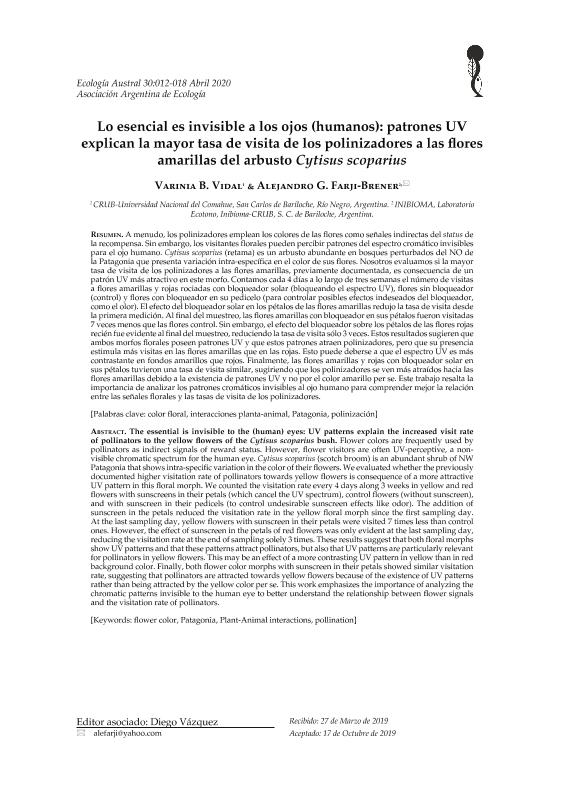Mostrar el registro sencillo del ítem
dc.contributor.author
Vidal, Varinia B.
dc.contributor.author
Farji Brener, Alejandro Gustavo

dc.date.available
2021-11-25T15:31:39Z
dc.date.issued
2020-03-25
dc.identifier.citation
Vidal, Varinia B.; Farji Brener, Alejandro Gustavo; Lo esencial es invisible a los ojos (humanos): patrones UV explican la mayor tasa de visita de los polinizadores a las flores amarillas del arbusto Cytisus scoparius; Asociación Argentina de Ecología; Ecología Austral; 30; 1; 25-3-2020; 12-18
dc.identifier.issn
1667-7838
dc.identifier.uri
http://hdl.handle.net/11336/147410
dc.description.abstract
A menudo, los polinizadores emplean los colores de las flores como señales indirectas del status de la recompensa. Sin embargo, los visitantes florales pueden percibir patrones del espectro cromático invisibles para el ojo humano. Cytisus scoparius (retama) es un arbusto abundante en bosques perturbados del NO de la Patagonia que presenta variación intra-específica en el color de sus flores. Nosotros evaluamos si la mayor tasa de visita de los polinizadores a las flores amarillas, previamente documentada, es consecuencia de un patrón UV más atractivo en este morfo. Contamos cada 4 días a lo largo de tres semanas el número de visitas a flores amarillas y rojas rociadas con bloqueador solar (bloqueando el espectro UV), flores sin bloqueador (control) y flores con bloqueador en su pedicelo (para controlar posibles efectos indeseados del bloqueador, como el olor). El efecto del bloqueador solar en los pétalos de las flores amarillas redujo la tasa de visita desde la primera medición. Al final del muestreo, las flores amarillas con bloqueador en sus pétalos fueron visitadas 7 veces menos que las flores control. Sin embargo, el efecto del bloqueador sobre los pétalos de las flores rojas recién fue evidente al final del muestreo, reduciendo la tasa de visita sólo 3 veces. Estos resultados sugieren que ambos morfos florales poseen patrones UV y que estos patrones atraen polinizadores, pero que su presencia estimula más visitas en las flores amarillas que en las rojas. Esto puede deberse a que el espectro UV es más contrastante en fondos amarillos que rojos. Finalmente, las flores amarillas y rojas con bloqueador solar en sus pétalos tuvieron una tasa de visita similar, sugiriendo que los polinizadores se ven más atraídos hacia las flores amarillas debido a la existencia de patrones UV y no por el color amarillo per se. Este trabajo resalta la importancia de analizar los patrones cromáticos invisibles al ojo humano para comprender mejor la relación entre las señales florales y las tasas de visita de los polinizadores.
dc.description.abstract
Flower colors are frequently used by pollinators as indirect signals of reward status. However, flower visitors are often UV-perceptive, a nonvisible chromatic spectrum for the human eye. Cytisus scoparius (scotch broom) is an abundant shrub of NW Patagonia that shows intra-specific variation in the color of their flowers. We evaluated whether the previously documented higher visitation rate of pollinators towards yellow flowers is consequence of a more attractive UV pattern in this floral morph. We counted the visitation rate every 4 days along 3 weeks in yellow and red flowers with sunscreens in their petals (which cancel the UV spectrum), control flowers (without sunscreen), and with sunscreen in their pedicels (to control undesirable sunscreen effects like odor). The addition of sunscreen in the petals reduced the visitation rate in the yellow floral morph since the first sampling day. At the last sampling day, yellow flowers with sunscreen in their petals were visited 7 times less than control ones. However, the effect of sunscreen in the petals of red flowers was only evident at the last sampling day, reducing the visitation rate at the end of sampling solely 3 times. These results suggest that both floral morphs show UV patterns and that these patterns attract pollinators, but also that UV patterns are particularly relevant for pollinators in yellow flowers. This may be an effect of a more contrasting UV pattern in yellow than in red background color. Finally, both flower color morphs with sunscreen in their petals showed similar visitation rate, suggesting that pollinators are attracted towards yellow flowers because of the existence of UV patterns rather than being attracted by the yellow color per se. This work emphasizes the importance of analyzing the chromatic patterns invisible to the human eye to better understand the relationship between flower signals and the visitation rate of pollinators.
dc.format
application/pdf
dc.language.iso
spa
dc.publisher
Asociación Argentina de Ecología

dc.rights
info:eu-repo/semantics/openAccess
dc.rights.uri
https://creativecommons.org/licenses/by/2.5/ar/
dc.subject
COLOR FLORAL
dc.subject
INTERACCIONES PLANTA-ANIMAL
dc.subject
PATAGONIA
dc.subject
POLINIZACION
dc.subject.classification
Ecología

dc.subject.classification
Ciencias Biológicas

dc.subject.classification
CIENCIAS NATURALES Y EXACTAS

dc.title
Lo esencial es invisible a los ojos (humanos): patrones UV explican la mayor tasa de visita de los polinizadores a las flores amarillas del arbusto Cytisus scoparius
dc.title
The essential is invisible to the (human) eyes: UV patterns explain the increased visit rate of pollinators to the yellow flowers of the Cytisus scoparius bush
dc.type
info:eu-repo/semantics/article
dc.type
info:ar-repo/semantics/artículo
dc.type
info:eu-repo/semantics/publishedVersion
dc.date.updated
2021-01-27T19:54:06Z
dc.identifier.eissn
0327-5477
dc.journal.volume
30
dc.journal.number
1
dc.journal.pagination
12-18
dc.journal.pais
Argentina

dc.journal.ciudad
Ciudad Autónoma de Buenos Aires
dc.description.fil
Fil: Vidal, Varinia B.. Universidad Nacional del Comahue. Centro Regional Universitario Bariloche; Argentina
dc.description.fil
Fil: Farji Brener, Alejandro Gustavo. Consejo Nacional de Investigaciones Científicas y Técnicas. Centro Científico Tecnológico Conicet - Patagonia Norte. Instituto de Investigaciones en Biodiversidad y Medioambiente. Universidad Nacional del Comahue. Centro Regional Universidad Bariloche. Instituto de Investigaciones en Biodiversidad y Medioambiente; Argentina. Universidad Nacional del Comahue. Centro Regional Universitario Bariloche. Laboratorio de Ecotono; Argentina
dc.journal.title
Ecología Austral

dc.relation.alternativeid
info:eu-repo/semantics/altIdentifier/doi/https://doi.org/10.25260/EA.20.30.1.0.911
dc.relation.alternativeid
info:eu-repo/semantics/altIdentifier/url/http://ojs.ecologiaaustral.com.ar/index.php/Ecologia_Austral/article/view/911
Archivos asociados
